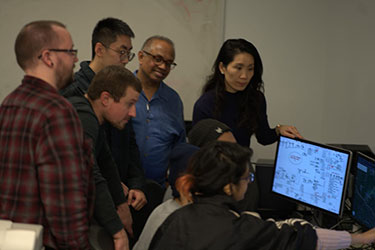“In case of a blackout, Mason would be able to meet its own energy demands."
— Liling Huang, associate professor in the Department of Electrical and Computer Engineering

Liling Huang, (right) an associate professor in the Department of Electrical and Computer Engineering, works with ECE seniors on developing a microgrid for the Fairfax Campus.
Imagine a day when canopies of solar panels across campus generate enough electricity to meet all of Mason’s power needs.
That’s the dream of seven senior engineering students and faculty advisor Liling Huang, an associate professor in the Department of Electrical and Computer Engineering (ECE).
The group is laying the foundation for this vision with their senior design project. “We are designing a microgrid for the Fairfax Campus, which is a localized power system that works alongside the main power grid,” says electrical engineering senior Annam Khan, the project manager.
“A microgrid is a defined, contained power system, consisting of its own electric loads and sources,” she says. “If it is built one day, it would allow Mason to generate and consume its own energy,”
The proposed microgrid would include several energy sources such as solar panels built on canopies over parking lots and parking decks. Natural gas-fired generators are also a possibility, she says.
This plan would allow the university to decrease its carbon footprint, become greener, and decrease its electricity bill, Khan says. “Our project takes a big step in tackling the idea of the future power grid at George Mason.”
Huang says the microgrid would be a smaller power system that can disconnect from the traditional macrogrid around the university and operate autonomously. “In case of a blackout, Mason would be able to meet its own energy demands,” she says.
“We might be able to generate more power than the university needs, so we could sell the extra power back to Dominion Energy,” says Huang, who is creating a new concentration in power and energy systems for the BS in electrical engineering and the BS in computer engineering.
She says some universities, such as Princeton and the Illinois Institute of Technology in Chicago, already have microgrids.
The electrical and computer engineering seniors are working on the feasibility and cost of the microgrid. They want to make sure the high up-front capital building investment required would pay off later in energy bill savings, Khan says.
Near the end of this semester, they’re going to Dominion Energy’s headquarters in Richmond to use lab equipment to verify their design.
“We’re not in charge of any of the actual building or construction. That’s a multimillion-dollar project that is far out of our scope,” Khan says.
The seniors are passionate about power engineering, and many plan to pursue careers in the field.
“This project gave us all the opportunity to get our feet into a new and innovative field with the future of the power grid,” Khan says. “People tend to think that power systems is an old, stagnant field, but it’s been growing with the advent of the microgrid, and the push for renewable energy."
Huang says she plans to have future senior design teams work on this project by taking this year’s plans and “advancing them to build the microgrid one day.”
Other members of the senior design team include Andrew Christiansen, Bradley Culebro, Cameron Evans, Sarah Fakhry, William Ferrando, and Tin Vo
